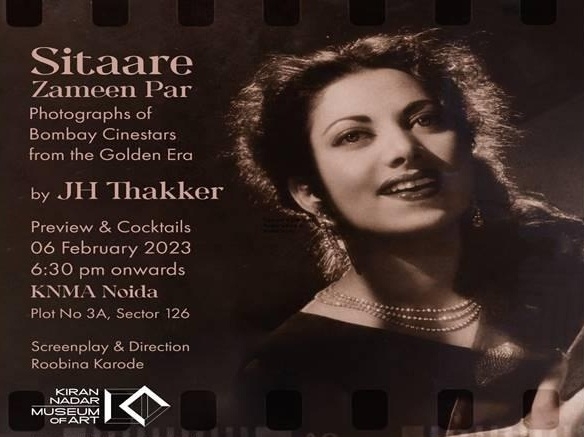New Delhi, Feb 7 (IANSlife) Musical melodies with evergreen lyrics that lingered, melodrama peppered with unforgettable dialogues, and the grandeur of a royal past or modern city serving to be the mise-en-scene of a romance: these were some of the major leitmotifs that the post-Independence Bombay cinema was known for. Revisiting the 'golden era' of the Bombay film industry and the faces behind them with a sense of nostalgia as well as fascination, since the world that they evoke is both timeless as well as transient. These figures from the past are like those distant and disappeared heavenly bodies which now exist only in their silver shadows, cast on the retinas of earthly beings. KNMA announced the nostalgia-fuelling exhibition and its 'first day first show' presenting the charm and opulence of the magical and sparkling 50s and 60s of Hindi cinema. This exhibition of the portrait photographs of Bombay cinestars by the eminent J H Thakker, offers a snippet of a particular chapter from the long history of celluloid in the subcontinent: the crucial decades roughly between 1947 and 1968. This interregnum coincides with what has widely been registered as the 'Golden Age of Hindi Cinema', when the post-Partition India became the second largest film-producing country in the world after Hollywood, partly due to the influx of migrants to Bombay (Mumbai) specifically from Lahore film industry in Pakistan. Thakker, also a Partition refugee, set up his 'India Photo Studio' at Dadar It is hard to forget Those bygone days, Days not meant to return - Why does the heart recall them? 2 in 1948, a spacious art-deco apartment which was to be graced by a constellation of upcoming and established actors of the Bombay cinema such as Dilip Kumar, Meena Kumari, Madhubala, Bharat Bhushan, Nargis, Raj Kapoor, Dev Anand and Nutan. A master of composition in black and white and sepia tones, he created magic developing his silver gelatin prints. Thakker quickly understood the exceptional role assigned to him-that of shining the glittering light of these stars on the earth, while masquerading as any other crew member on the movie set. Thakker not only utilised his technical acumen and astute sense of the 'chiaroscuro' (the light and dark gradation of tones) but deployed imagination to formalise and posture glamorous subjects as the icons of popular romance. Within these "temples of desire" exquisitely perfumed by timeless music, song and dance compositions, Thakker's practice can be contextualised as that of an idol-maker. The newly Independent India had a vexed relationship with the burgeoning film industry, despite the role it would play in cementing nationalist values and the creation of popular stars across cultural differences. By the year 1968, Thakker, as Bombay cinema's favourite photographer, had distanced himself from the world of stardom. He was disillusioned by the sharp changes in production process wherein the Technicolour reigned supreme and actors were no longer required to spend long hours at the photo studio for promotional stills. Instead, Thakker now preferred to use his vast repertoire of photographic talent to image the common people with the same interest. In 2003, the expert lensman joined his beloved stars in the night sky, leaving behind countless photographs and memories of an era of filmic time. Preview: February 6, 2023 Dates: February 6- April 30 Venue: KNMA, HCL Technologies, Sector 126, Noida - Uttar Pradesh The opening of the show will be by the legend of the silver screen 'Sharmila Tagore'. (IANSlife can be contacted at ianslife@ians.in)
Portrait photographs of Bombay cinestars from the Golden Era
- by Rinku
- February 07, 2023 2 minutes

Portrait Photographs of Bombay Cinestars from the Golden Era(ianslife)











